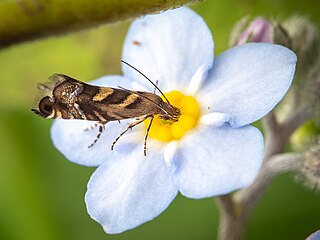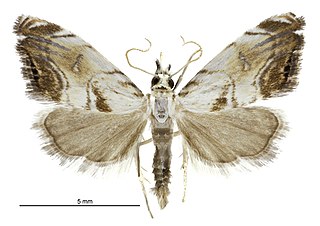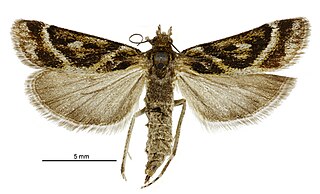
Glaucocharis chrysochyta is a species of moth in the family Crambidae. This species was first described by Edward Meyrick in 1882. It is endemic to New Zealand and is found throughout the country. It inhabits native forest. Larvae appear to feed on moss and likely pupate there. Adult moths are on the wing from November to March. They fly at night and are attracted to light.

Glyphipterix achlyoessa, commonly known as the cocksfoot stem borer, is a species of moth in the family Glyphipterigidae. It is endemic to New Zealand and can be found throughout the country. This species inhabits meadows and open grasslands. The larvae are hosted by species in the genus Juncus as well as by the species Dactylis glomerata. Adult moths are commonly on the wing from October to December.

Mnesarchella loxoscia is a species of primitive moth in the family Mnesarchaeidae. It is endemic to New Zealand. and is found in the Northland, Auckland, Coromandel, Waikato, Bay of Plenty, Taranaki, Taupō, Gisborne, Rangitīkei, Wellington and the Marlborough Sounds regions. Adults of this species are normally on the wing from December and January but can be on the wing as early as October.

Glyphipterix acronoma is a species of sedge moth in the genus Glyphipterix. It is endemic to New Zealand and is found in the North and South Islands. It's preferred habitat is open fields on mountain sides and adults are on the wing in December and January.

Glyphipterix tungella is a species of sedge moth in the genus Glyphipterix. It is endemic to New Zealand and is found throughout the country. Larvae mine the leaves of small sedges. Adults of this species are day flying and inhabit sheltered scrub or grassy areas and forest clearings.

Ichneutica omoplaca is a moth of the family Noctuidae. It is endemic to New Zealand. It is widespread from the Bay of Plenty in the North Island down to Southland in the South Island. Specimens have also been collected from the Auckland Islands. It lives in a variety of habitats including beech forest clearings and tussock grasslands. This species has been recorded that some of the larval hosts of this species include Poa cita, Dactylis glomerata and it has been reared on Plantago lanceolata. The larva is undescribed but pupae have been found in a pine plantation in soil under weeds. Adults of this species are on the wing from October to March. The adult moths are variable in appearance but the diagnostic feature is the pale ochreous to white colouring between the basal streak and the costa which contrasts with the ground colour of the forewing.

Stathmopoda campylocha is a species of moth in the family Stathmopodidae. It is endemic to New Zealand. It is classified as critically endangered by the Department of Conservation.

Glaucocharis harmonica is a moth in the family Crambidae. This species was described by Edward Meyrick in 1888. It is endemic to New Zealand and is found in the North and South Islands. It inhabits lowland to subalpine native forest. It has been hypothesised that there are two broods per year. The larval hosts are unknown. Adults are on the wing from October until January.

Pyrgotis plinthoglypta is a species of moth of the family Tortricidae. It is endemic to New Zealand and is found throughout the whole country. The preferred habitat of this species is native forest. The larvae of this species feeds on rimu leaves from under a silken web. It pupates in loose cocoons amongst rimu foliage. Adults are on the wing from October to May and are night flying. They are attracted to light and can be collected by beating their host tree. The adult insect resembles a small dried fragment of rimu foliage when at rest.

Pyrgotis transfixa is a species of moth of the family Tortricidae. It is endemic to New Zealand. It is classified as "At Risk, Naturally Uncommon" by the Department of Conservation.

Eudonia xysmatias is a moth in the family Crambidae. It was first described by Edward Meyrick in 1907. This species is endemic to New Zealand and has been observed and collected in Otago. This species inhabits wetlands. Adults are day flying and are on the wing in December and January.

Elachista helonoma is a species of moth in the family Elachistidae. This species is endemic to New Zealand. It is classified as "At Risk, Relict'" by the Department of Conservation.

Tinea belonota is a species of moth in the family Tineidae. It is endemic to New Zealand. It is classified as not threatened by the Department of Conservation.

Orocrambus sophistes is a moth in the family Crambidae. This species is endemic to New Zealand and has been observed in South Island at the Mackenzie Basin, Central Otago and Otago Lakes areas. This moth is a dryland specialist and inhabits short tussock grasslands. The larval host species is Festuca novae-zelandiae. The adults of this species have been observed from mid January to April with the female being flightless. The adult male is attracted to light. This species has been classified as Nationally Vulnerable by the Department of Conservation.

Tingena crotala is a species of moth in the family Oecophoridae. It is endemic to New Zealand and is found both in the North and South Islands. This species inhabits native forest and is on the wing in November and December.

Tingena hemimochla is a species of moth in the family Oecophoridae. It is endemic to New Zealand and has been observed in the North Island. Adults of this species are on the wing from December until March.

Tingena oxyina is a species of moth in the family Oecophoridae. It is endemic to New Zealand and has been observed in the Otago region. This species inhabits native beech forest at altitudes of between 1000 – 3000 ft. Adults of this species are on the wing in January.

Asaphodes nephelias is a moth in the family Geometridae. It is endemic to New Zealand and has been observed in the South Island. The preferred habitat of this species is alpine tussock grasslands above native forest and in wetlands. The adults of this species are on the wing from January to March and are day flying. The female has brachypterous wings.

Atomotricha sordida is a moth in the family Oecophoridae first described by Arthur Gardiner Butler in 1877. It is endemic to New Zealand and has been observed in the South Island in the Canterbury and Otago regions. The adult female of the species is brachypterous.

Trachypepla leucoplanetis is a moth of the family Oecophoridae first described by Edward Meyrick in 1883. It is endemic to New Zealand and has been collected in both the North and South Islands. It is the smallest moth species in the genus Trachypepla and the patterns on the forewings of adults are variable in appearance. It inhabits native forest and bush and the larvae feed on leaf litter. Adults are on the wing from October until February. T. leucoplanetis is regarded as being rarely observed and has been collected via the beating of foliage.





















